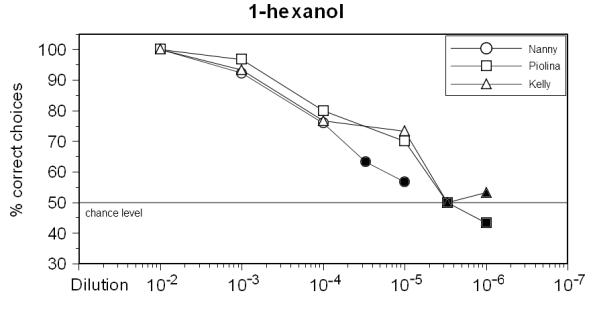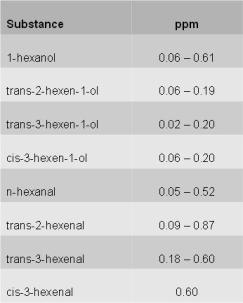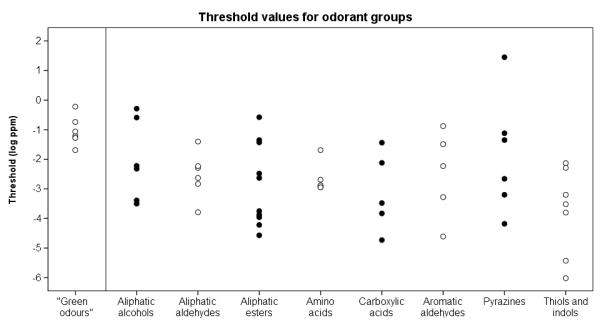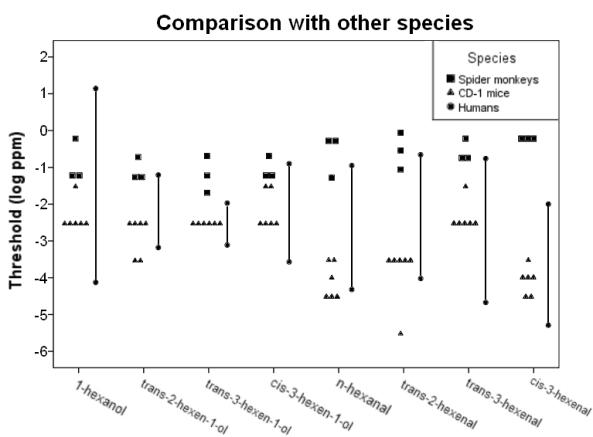Conclusion
Based on the results in this study, I could draw the following conclusions:
- Spider monkeys have a well-developed ability to detect "green odors"
- The type of functional group affected olfactory detection threshold values in a systematic manner, but presence, position and configuration of a double bond did not
- Spider monkeys are not as sensitive to "green odors" as to previously tested odorant groups
- They are less sensitive to "green odors" than mice and humans
- Behavioral relevance may explain between- and within-species difference in olfactory sensitivity
Below, you can read about the results in detail.
Results and discussion
Odorant results
For each of the eight odorants, I got a graph like the one for 1-hexanol below, showing that in the beginning, the monkeys could easily discriminate the odorant from the odorless solution (100% correct choices). When the odorant was more diluted, it became harder and harder for the monkeys, until they finally could not discriminate it significantly from the odorless solution (less than 70% correct choices).

Performance of the spider monkeys in detecting 1-hexanol. Filled symbols are below the threshold value.
With all odorants, the monkeys detected concentrations below 1 part per million (ppm), with single individuals performing even better. This means that spider monkeys have a well-developed ability for detecting "green odors". The table below shows the range of olfactory detection threshold values for each of the different odorants.
Olfactory detection threshold values for the eight odorants.

The spider monkeys could detect alcohols at lower thresholds than aldehydes, showing that the type of functional group present in the molecule affected olfactory detection threshold values in a systematic manner.
Presence, position and cis-trans configuration on the other hand was not found to have any such effect.
Comparison with other odorants
The olfactory detection thresholds for "green odors" are not as high as those for odorants from other chemical classes. The olfactory detection thresholds obrained for "green odors" are generally higher than or in the higher range of thresholds obtained for other odorants in previous studies.

Comparison of olfactory detection threshold values of spider monkeys for different odorant groups. Each symbol represents the lowest threshold value for each odorant.
Comparison with other species
Olfactory detection thresholds have also been obtained for humans and mice. As you can see in the figure below, spider monkeys appear to be less sensitive to "green odors" than both the mice and the best-performing humans.

Comparison of the olfactory detection thresholds for "green odors" in spider monkeys, humans and mice. For spider monkeys and CD-1 mice, each symbol represents the threshold value of one individual for the odorant. For humans, the top circle represents the highest reported mean threshold, and the lower circle represents the lowest reported mean threshold. The line drawn between the two points represents the range of mean threshold values reported.
Differences in olfactory sensitivity
There may be several explanations why species differ in olfactory sensitivity. It has, for example, been suggested that olfactory sensitivity is correlated with the number of functional olfactory receptor genes. A high number of such genes should lead to a larger olfactory repertoire, which may help in detecting odorants. Another possibility is that differences in olfactory sensitivity may be explained by the absolute or relative size of olfactory brain structures in the species. However, the findings in this study and in previous ones do not support these suggestions, indicating that neuroanatomical and genetic comparisons across species do not allow us to draw conclusions concerning the olfactory sensitivity of the species.
Another possible explanation for differences in olfactory performance between species is the behavioral relevance of the odorant. If an odorant is behaviorally relevant for a species, then this species should be expected to display a high sensitivity for this odorant, whereas another species may be relatively insensitive to the same odorant if it does not contain information that is relevant. An increasing number of studies now suggest that behavioral relevance is an important factor in determining olfactory sensitivity of a species to an odorant.
This may also apply to within-species differences, in explaining why a species is more sensitive to one specific odorant or an odorant group than another. The somewhat lower olfactory sensitivity of spider monkeys to "green odors" may be explained by the fact that other chemical classes have a higher behavioral relevance. Detecting "green odors" may not be as beneficial as detecting, for example, aliphatic esters, an important odorant group in fruit.
That being said, spider monkeys do have a well developed sensitivity for "green odors", and we must not draw the conclusion that this group of odorants is unimportant to the species.
Want to see even more?
or
Responsible for this page:
Director of undergraduate studies Biology
Last updated:
05/20/11
